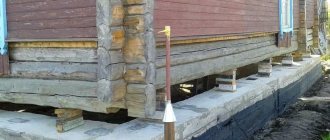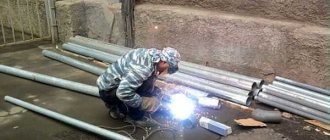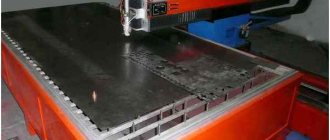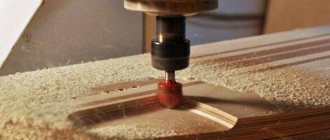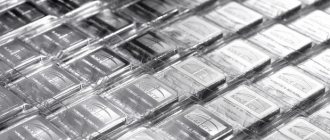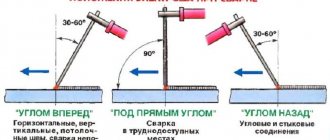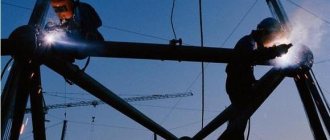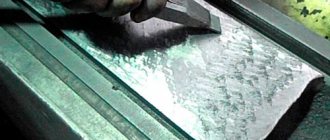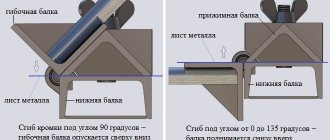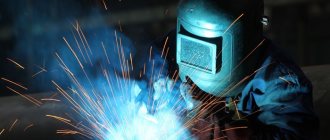02/14/2019 Author: VT-METALL
Issues discussed in the material:
- How to choose the most economical method of cutting metal
- What are the main methods of cutting metal
- How to select a method and cut metal after cutting
In the technological chain of manufacturing metal structures, cutting of profiled metal products plays an important role. The complexity of further processing and assembly, as well as the quality of the finished product, depends on how accurately and correctly this operation is performed. Over the long history of metalworking, a large number of different technologies have been developed. In our article we will look at the main methods of metal cutting that are used in modern manufacturing enterprises.
How to choose the most economical method of cutting metal
When cutting, special attention is paid to the location of the workpiece on the strip or sheet of metal. Most often, product blanks have a shape close to rectangular, but often there are parts that have a more complex contour.
In the process of manufacturing metal blanks, waste is generated, the volume of which is determined by the correct choice of cutting method.
There are two types of waste generated during the production of metal products:
- Process waste refers to material that is lost due to melting during cutting (melting during high-temperature cutting and chips or irregularities during mechanical cutting).
- Cutting waste consists of the material of sheets, strips, rods, etc., which remains untouched by a certain method of manufacturing blanks.
The production of cutting waste is determined by two factors, according to which they can be divided into two groups:
- mold waste;
- non-recycling waste.
Mold waste is material that is located between the contours of several workpieces within a rectangle that encloses their shapes and remains unused (for example, between the abed rectangle and the perimeter of the workpiece).
VT-metall offers services:
Non-recyclable waste refers to unused sheet metal or other rolled metal, the dimensions of which are greater than the sum of the dimensions of the workpieces.
In order to obtain the largest possible number of blanks from rolled metal, it is necessary to select the most optimal cutting method, which is accompanied by the least amount of waste. To do this, you need to take into account the features of the technology for obtaining blanks.
Basic methods of cutting metal
In production, to optimize metal cutting, the most advantageous technology for separating rolled metal into blanks is selected. For example, the advantage of using a torch or rotary shear is that the blanks for production can be placed anywhere on the sheet metal. If guillotine shears are used to cut the material, then a number of restrictions appear on the choice of location of the workpiece contour. It should be positioned in such a way that it is possible to perform a straight cut along the length and width of the sheet and straight cutting at an angle.
We recommend articles on metalworking
- Steel grades: classification and interpretation
- Aluminum grades and areas of their application
- Defects in metal products: causes and search methods
For industrial production of large batches of products, it is more logical to use a combined cutting method. In this case, blanks of various shapes are combined in such a way that they can be folded into rectangles with the smallest possible dimensions. With the help of such rectangles, the filling of the metal sheet is optimized.
The method of rationally filling the sheet along the width ensures a reduction in the volume of non-folding waste. The unused part of the sheet in this case will be smaller than when the forms are arranged along the length of the sheet. It is necessary to select a combination of blanks in such a way that the sum of their sizes contributes to the most complete filling of the smaller side of the sheet. The same technique is used to mark along the length of the sheet.
The marking method by forming dimensional sequences involves placing blanks for cutting from larger to smaller ones. The task of optimizing metal cutting is solved by special technological groups. They receive a monthly request from production units, which indicates the required types of workpieces. The application contains the order number, drawings of finished products, grade of metal and standards for its consumption. Based on the received drawings, employees of the technological groups group products by metal grade and the required thickness of the workpieces.
After this, taking into account the dimensions of the metal sheets that are present in the enterprise’s warehouse, cutting maps are drawn up. First, the approximate number of required sheets of metal is calculated. Then the technologists draw their dimensions on the most convenient scale. In the same size it is necessary to cut templates for making blanks on paper. The cut stencils are combined on the drawings of metal sheets in such a way as to minimize costs.
After completing work on technological cutting charts, a picking list is drawn up. Based on the data in such a document, you need to select the metal and transfer it along with the documentation to the workshop. For the performer of the blank production process, the working document is the cutting map. If, in order to produce the required number of blanks, only a part of a whole sheet of metal is needed, then the remaining material, which is called “business waste,” is returned to the warehouse with an appropriate entry made in the accounting documents.
The method of cutting metal described above is called operational, since it is based on obtaining information about the availability of material in the warehouse. In production, the method of perspective cutting can also be used. It is applicable for mass production of repeating products. In this case, technological maps are drawn up approximately 6 months before the release date of a batch of products and an order for a measuring sheet is placed on them.
Cutting plans are not drawn up if the workpieces are made not from sheet metal, but from rolled profiles. Rods, channels, angles and other rolled products are issued to production areas in length measurements, taking into account the dimensions of the workpieces and allowance standards for cutting. After cutting is completed, the remains are marked and transferred to the warehouse. To optimize the consumption of rolled profiles, metal blanks should be produced centrally. The selection of materials is carried out depending on the brand, profile and size so that the workpiece is a multiple of the dimensions of the rolled metal.
What it is?
Metal cutting - marking parts on a metal sheet, and not just marking, but placing them with the greatest economy in order to use the sheet with a minimum amount of waste. The less waste, the cheaper the part is. They can be completely avoided only with products of the correct geometric shape; shaped blanks, as a rule, have a large number of uneven lines and curves.
Proper cutting of metal is one of the main ways to reduce the cost of manufacturing a metal product.
Basic methods of metal cutting
Guillotine cutting.
In the field of metal products production, a variety of equipment is used that allows efficient cutting of metal in different ways. For cutting materials with a thickness of 0.45–2.5 mm, simple mechanical devices are used, and for thicker metals (20 mm), electric or pneumatic guillotine-type shears are used (such equipment allows for direct, clean cuts).
Affordable mechanical guillotine equipment (for example, machines for cutting metal sheets) is popular in the construction industry for the production of products from galvanized sheets or metal tiles. Using such devices, window sills, cornice overhangs and other elements are made. The biggest disadvantage of guillotines (hydraulic, pneumatic or electromechanical) is that such equipment can only perform straight cuts.
Metal cutting with band and circular saws.
If the chosen method of cutting metal does not require high precision, then the most popular solution for cutting the material would be to use an angle grinder (a regular “grinder”).
Stationary saws that can handle large-diameter blades allow you to produce workpieces with more accurate dimensions. Such equipment is used in small-scale production of metal products for construction and industry. When choosing this cutting method, the cutting thickness is 0.08 cm. Its advantage is that the material can be cut at an angle. But in this way it is very difficult to make a figured cut along a curved perimeter.
Perforating presses.
In the industrial production of aluminum structures or for finishing metal sheets (for example, for the production of expanded metal sheets), special expanded metal presses are used.
Oxygen gas cutting
– a highly productive method of cutting metal, which is used in various production areas. Its disadvantage is that it produces a wide cut, along the edges of which scale with unevenness is formed. In addition, the oxygen gas river cannot be used for cutting thin sheets of metal.
Laser and plasma cutting of metal
The main advantage of this cutting method is the high productivity of the process and the ability to perform figured cuts when making blanks from metal sheets.
For plasma cutting, the technology of heating the metal in the area of the cutting line is used with further removal of the melt by a plasma flow. For this purpose, the energy of an electric arc is used. The high temperature of the ionized gas flow (from +15,000 to +30,000 °C) provides the necessary speed for cutting metal. Plasma cutting is the most effective way to cut metal sheets.
Considering the advantages of this method, in addition to high cutting accuracy, we should highlight:
- Possibility of use for the production of workpieces of complex shapes.
- No thermal deformation of the metal.
- Efficient for producing repeatable, uniform products with contour tolerances of up to 0.5 mm.
- The cutting method is completely safe and environmentally friendly.
- Possibility of use for cutting ferrous metal, as well as stainless steel of different thicknesses.
The plasma cutting method can be used for:
- Aluminum blanks up to 12 cm thick.
- Copper and bronze alloys up to 8 cm thick.
- Alloy steel sheets up to 5 cm thick.
Different permissible cut thicknesses for different metals are due to their thermal conductivity characteristics. The thicker the sheet, the less economically profitable this cutting method is, since energy costs increase significantly.
Results
The choice of metal cutting technology begins with drawing up technical requirements. The thickness, material properties, and configuration of the workpiece are taken into account. Based on this, the optimal cutting technique is determined.
The next important point is the formation of a cutting map. It should make the most efficient use of the entire sheet area and ensure the minimization of non-business waste. To perform this task, specialized software systems are used.
The setup and technical condition of equipment and cutting machines directly affects the quality of the work performed. It is necessary to periodically carry out diagnostics, scheduled repairs and replacement of components.
To effectively cut metal, all factors should be taken into account - from the choice of technology to the actual condition of the equipment. This is important not only for mass production, but also for the manufacture of piece products.
Disadvantages of plasma cutting:
- Increases edge hardness at high temperatures.
- The presence of a tarnished zone and a rainbow change in color of materials along the cutting line.
The catalogs of manufacturers of metalworking equipment present a wide selection of devices of different classes. For cutting metals, contact devices demonstrate high efficiency. This cutting method is based on the use of an electric arc between a sheet of material and an electrode.
Main elements of plasma cutting equipment:
- The plasma torch ensures the conversion of electric arc energy into plasma heat.
- Power supply.
- A compressor or gas cylinder provides a gas jet.
Only highly qualified specialists can cut metal using plasma cutting. It is necessary to maintain a stable gap between the sheet plane and the nozzle. This is a rather complex and responsible process, since uneven movement of the cutter during cutting causes the appearance of sagging along the edges of the metal and the formation of scale. The laser cutting method is based on focusing radiation, in which thermal energy is concentrated, at the cutting point. When using this technology, it is possible to obtain thin cuts with high accuracy and minimal distances between marking lines. The cutting process itself is fully automated. Robotic equipment carries out precise movement of the laser according to electronic drawings, which are entered into the machine program.
Advantages of laser metal cutting:
- Ability to cut along complex closed curved contours.
- Economical material consumption is ensured by the most dense arrangement of workpiece parts on a sheet of metal and the use of software cutting, which reduces the likelihood of errors.
- Metal cutting is carried out without prolonged mechanical or thermal effects, so the edges of the workpieces are not deformed and there is no tarnishing color.
- After cutting the workpiece, perpendicular edges with a low roughness coefficient are obtained.
Disadvantages of cutting metal with a laser:
- The thickness of the metal cannot exceed 2 cm.
- When using this cutting method, cutting performance decreases significantly when processing materials with high reflective characteristics (for example, polished stainless steel). This is due to a decrease in laser power.
Laser cutting of sheet steel is widely used in the production of serial parts with high precision requirements in the automotive industry, in the production of high-precision equipment, exclusive decorative products, etc.
Laser and plasma cutting methods are relatively new technologies that are becoming increasingly used in various fields.
Common Mistakes
The main types of errors when cutting metal can be divided into calculation and technological. The first ones appear when the cutting pattern is formed incorrectly; the dimensions of the parts and the order of their arrangement on the sheet are not taken into account. These inaccuracies can be minimized using cutting programs. In paid versions, it is possible to organize stream production; business balances from previous cuttings are taken into account.
Examples of technological errors for various types of metal cutting:
- Plasma cutting. Incorrect operating mode will lead to the formation of defects. Additionally, there will be severe wear of the nozzle, the consequences of which are stretching the arc and widening the cut.
- Laser processing. Rapid passage of the beam can cause burrs to appear - hardening of beads on the edge. It is necessary to adjust the guide frame; its wear affects the accuracy of the cut.
- Mechanical cutting. A common cause of edge bending is a dull edge of a disk, guillotine or blade. Also, sheet fixation is important for machining.
To optimize the process and obtain high-quality workpieces, several cutting technologies can be used. This is relevant for the manufacture of complex-shaped products or for organizing constant flow production. The main advantage of this approach is the reduction of waste, which has a positive effect on product costs.
How to choose a metal cutting method based on the cutting method
As noted earlier, the correct choice of cutting method is a very important stage in the manufacture of blanks and sheet metal parts. A number of points depend on this: the quality of the edge, the accuracy of the cut, the amount of material waste and additional processing after cutting.
| Guillotine | Oxygen gas cutting | Plasma cutting | Laser cutting | Waterjet cutting | |
| Cutting cost | Average | Average | Low | Low | Very high |
| Thickness of the metal being cut | Up to 20 mm black steel, up to 16 mm stainless steel | Up to 350 mm | Up to 100 mm | Up to 16 mm | Up to 300 mm |
| Stamps | Ferrous stainless steel, aluminum, copper alloys | Metals with high melting points | Ferrous stainless steel, aluminum, copper alloys | Ferrous stainless steel, aluminum, copper alloys | Any |
| Edge quality | Burrs | Hardened edge, poor quality | Hardened edge, poor quality | High | High |
| Edge roughness | Small, Rz40 | Very high from Rz100 | High Rz60–100 | Minimum Rz5-10 | Rz20–80 |
| Cutting width | 0.1 mm | Up to 20 mm | 2-3 mm | 0.15–0.3 mm | 0.2–1 mm |
| Thermal influence | Absent | Very high | Very high | Average, 0.2 from the edge | Absent |
| Accuracy | Low | Low | Average | Very high | Very high |
| Curly contours | No | Yes | Yes | Yes | Yes |
| The need for post-processing | Large amount of work | High, the edge will be hardened | High, the edge will be hardened | Virtually not required | Virtually not required |
| Advantages | Beneficial for the production of corners and straight strips | Relatively high performance | High performance | Manufacture of complex contours with high precision at low cost and high production speed | Processing of almost any materials without thermal influence |
| Flaws | Only preparatory work, in the future it will require large costs to complete the product | Low precision, hardened edge, will require more effort to complete the product | Low precision, hardened edge, will require more effort to complete the product | Relatively small thickness of the processed material | A very expensive type of cutting |
Guillotine cutting (guillotine shears)
Machine design: the presence of an upper (movable) and lower (fixed) blade, between which a sheet of metal is placed. Knives can be straight or arched.
The principle of influencing metal: the principle of ordinary scissors is to fix the metal between the blades and apply pressure on the sheet with great force with the sharp edge of the upper blade.
Purpose: direct longitudinal and transverse cutting of sheet and strip metal, metal alloys and steel. With the help of a guillotine, it is possible to make straight and simple cuts that do not require figurework.
Advantages:
- a high-quality cutting machine produces a minimal amount of metal chips (waste)
- an even cut that does not require additional processing (also only possible if the device is well sharpened and the gap is correctly set using a specialized table). Otherwise, a sharp dangerous protrusion will form on the lower edge - a burr.
- fairly high cutting speed
- good cutting accuracy
- no need to pre-prepare the metal
- no temperature effect on metal
- low cost due to simple production technology
Flaws:
- impossibility of cutting thick sheets (more than 20 mm)
- impossibility of creating complex and shaped blanks
- for a good result, it is necessary to carefully set the gap and adjust the relative position of the knife and metal
- powerful and productive guillotines are stationary, mobile and portable devices noticeably lose efficiency
Types of guillotines:
- hydraulic - work due to hydraulic drives. They have a fairly large power reserve (cut sheets up to 20 mm), high productivity, noiselessness and smooth operation, therefore they are usually used in mass production. The disadvantage is the large mass and weight, difficulty in moving.
- electromechanical - works on an electric motor, which transmits force to a beam with knives. Upon completion of the engine revolution, the knives return to their original position. They have increased speed and efficiency (more than a hydraulic guillotine) - they can make up to 30 cuts in a minute. Disadvantage: noisy operation. There are both full-size and small-sized (and low-power) models for private work - they, of course, are not capable of cutting thick sheets, but are quite suitable for private workshops or garages.
- pneumatic - driven by a compressor with compressed gas. In terms of performance they are close to electromechanical ones and also operate with a certain noise level. Today they are widely used in large mass production. Pneumatic machines are also convenient because CNC (computer numerical control) can be installed on them quite easily. The combination of pneumatics and electronics increases cutting speed and accuracy at the same time.
- manual - operate using a lever or pedal (hand or foot control, respectively). Here the main work is done by the upper knife, which is lowered onto the product along one trajectory or another. This equipment is not suitable for cutting thick sheets, carbon and alloy steels. It is mainly used in small private workshops.
